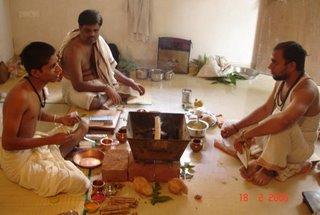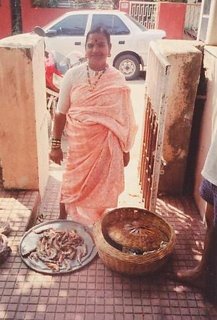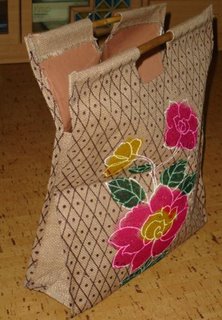'India Week' - Way of Life - Part II
The next couple of pictures are about customs that people follow in Hinduism. No matter how much I tell you about what I've seen here, I won't be anywhere near to scratching the surface of all there is to tell. My first experience with such customs was with aarti, when Ishan and I visited his relatives' homes for the first time as a newlyweds. The married women performed aarti to me also on my 'Indian Baby Shower' (Godh Bharna) and I performed it to Ishan's father on his birthday.
When Fabi was just a few months old, one of the neighbors insisted we go visit her. I finally got around to go to her house on a Friday and I came back with a red bindi (dot) on my forehead and wearing flowers on my head. (Unfortunately, I lost that picture when my hard disk crashed.) It turned out that I had visited her on an auspicious day and therefore I got that special treatment. It was just one of those days when a married woman visits your house is a good sign.
There are so many customs. For example, there's a special ceremony when a baby gets his first bite of solid food; and there's also the time to remember the ancestors and people actually refrain themselves of things such as buying a new house during such time. It's always about waiting or celebrating during an auspicios time, for example, the exact time for a wedding to take place.
The elements involved in the ceremonies are also interesting, as they are full of meaning.
The next picture I want to show you is what the neighbor's daughter brought me one day. It's part of a monthly prayer (pooja) she's doing. She visits a married woman each month for a year starting with her own mother. Each time -as part of the prayer - she takes fruits, rice (an amount which is determined by weight), flowers, a betel leaf, a piece of cloth (which would be used to make a sari blouse), among other things. The purpose is that each time she visits a married woman, she can learn something about married life and the year long offering will help her find a good husband. Here's a picture of three priests performing a Vastu Shanti, which is a housewarming ceremony that is celebrated before a couple moves into their new home.
Here's a picture of three priests performing a Vastu Shanti, which is a housewarming ceremony that is celebrated before a couple moves into their new home.
The following three pictures are dedicated to people who play an important role in our life here.
The couple you see in the next picture are in charge of collecting the trash from each home in our sector EVERY day.

Here's another VERY important person, our dhobi
. Normally, 'dhobi' designates the person who does the laundry, but in this case he's in charge of coming to your house and taking the clothes you want him to iron. The next day he returns them neatly pressed. He takes loads of clothes back and forth in his bicycle. Heavy irons are used to press the clothes and they are heated with coal. It's probably the worst job to have in the summer! Ishan thinks that setting up a 'dhobi' service in Costa Rica would be a good business. I'm sure many people would be willing to pay for someone to relieve them of the agony of hours standing by the ironing board.

Here's a very proud looking fisherwoman offering her fresh goods. Ishan's parents really like fish, so she knows she's got customers when they come to visit.

Yes! It's true! You do see elephants on the streets and highways in India. Of course, they're not intended for public transportation (at least in Mumbai!) When my parents came to India they saw their first elephant on the highway on their way from the airport. The picture below was taken in Vashi. Once I read an article about how elephants were disrupting traffinc in Delhi, so they now have a specific time in the evening when they can walk the streets, and since it gets dark, they have to wear light reflectors so that the cars and trucks don't miss them.

Here trucks are almost always seen in the MIDDLE of the road instead of driving in the center of their correspondent lane. It's common to see signs at the back of the trucks 'HORN OK PLEASE', indicating that if you want them to move into their lane, the driver DOESN'T mind if you honk at them! It's the complete opposite in Costa Rica, where honking is considered very rude, but people still do it. (Unlike in Germany, where it's also very rude and people hardly ever honk - probably only in an emergency.)
 Speaking of the Costa Rican honking practices...when you're the first one waiting for the traffic light to change (also known, as the 'signal' here in India), the car(s) behind you will surely honk in a plank! I was thrilled to see that the traffic lights here have a counter. Look at the picture below where I have circled the counter. Isn't it great? You know exactly how many seconds are remaining before the light changes!
Speaking of the Costa Rican honking practices...when you're the first one waiting for the traffic light to change (also known, as the 'signal' here in India), the car(s) behind you will surely honk in a plank! I was thrilled to see that the traffic lights here have a counter. Look at the picture below where I have circled the counter. Isn't it great? You know exactly how many seconds are remaining before the light changes! In this picture you can also notice a couple of BEST (Bombay Electric Supply and Transport) buses crossing the road and also a woman dressed in a sari in the left-hand side of the picture.

This is the last picture related to traffic. I've pointed out an auto-rickshaw, a very practical and popular means of public transportation for short distances. Notice the woman on the left-hand side of the picture: she's wearing another traditional Indian outfit, the salwar-kameez.

I have reserved my favorite picture to end this 'India Week'. It was another culture-shocker for me. I'm glad my cellphone had a camera because I was able to take this picture in a store and now I'm sharing it with you. The picture is a detail of a toy kitchen set. Here's what caught my attention: The box says "Train your Daughter to be a good Daughter-In-Law".
I will give a moment to all of you who are reading this and think you need to recover from the same 'shock' I got.
You see...I'm sure my Mom wanted me to learn how to cook because it's important for everyone to be independent and preparing food is definitely in the list of needed survival skills. My Mom also told me that the best way to get to a man's heart was through his stomach, but I was hoping to find someone like Jamie Oliver. In case I ever ended up with a tiny baby who depended on me for his food I already had planned on being the number 1 customer for Gerber until the baby would learn how to cook for himself...and later on, hopefully cook for me too!
So, according to my upbringing I would understand if the box with the kitchen toy set would have read:
"Train your Daughter to be a good Cook"
"Train your Daughter to be a good Wife"
"Train your Daughter to be a good Mother"
or even better:
"Train your Kid to be a good Cook" (I'm hoping to teach Fabi to cook...and not just because I want him to cook for me!)
So, unless you have seen how the family dynamics work here in India, a comment like the one on the box just boggles the mind (to say the least!) When I was getting the first taste of how my life had changed with Fabi, I mentioned that in some societies in Africa, I wouldn’t even be considered a woman because I didn’t know how to cook. I guess in these places in Africa, the box would read: "Train your Daughter to be a person"....so I guess the Indian version is not so bad after all!

Labels: Life in India






1 What say? / Que me dicen? - Comments:
The idea behind the sign "Train your daughter to be a good daughter-in-law" is to give a break to the mother-in-law, so that she wouldn't have to be cooking for her son.
Post a Comment
<< Home